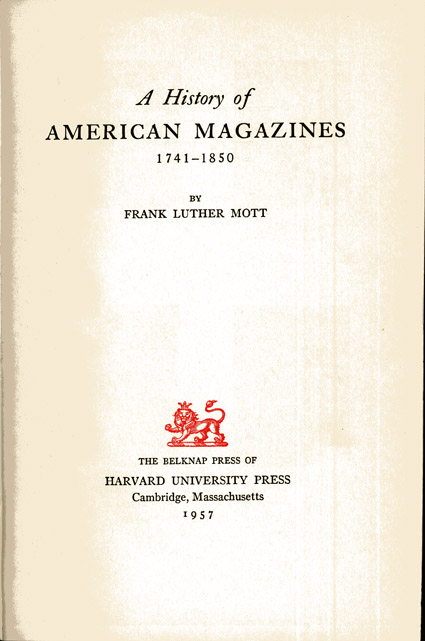Introducing an Index of American Magazines: 1741:1826
- by Bruce E. McKinney

The indespensible first source for the study of American magazines
By Bruce McKinney
Most books are read from front to back but I challenge you to try to do this with any of the five volumes of Frank Luther Mott's A History of American Magazines. Every page has references to other pages, to footnotes and to indexes and it simply isn't possible to read any of the volumes as a book unless you simply decide to ignore all the bibliographical tendrils. Each one is a door into something curious and interesting. I couldn't ignore them and in time simply surrendered to the logic of the material and have read volume one [848 pages] as an extraordinary reference work rather than as a pure history. I'm not alone in finding this material interesting. Dr. Mott received a Pulitzer Prize in 1939 for what was, to that point a three volume set. By the late 1950s the series reached five volumes and its full complement of 4,000 pages.
What Dr. Mott sets out to do is to chronicle the entire history of American magazines, those perishable intermediaries that live between newspapers and books and he succeeds in bringing to life a research and collecting category that is still today consistently ignored by mainstream dealers, auction houses and collectors. Dr. Mott reminds us that we ignore this material at our peril and he does it in the most convincing way - by integrating publications into periods, categories and types so that what by itself may be a single issue of a publication becomes a thread in a complex tapestry of developing perspective interpreted as local, regional and national history, across developing fields such as drama, religion and social change - always interpreted through the lens of personal perspective. If in books it can be difficult to uncover the human that writes the words, with magazines the human sentiment and perspective is much closer to the surface. If with books the author is almost always masked, with magazines the publishers and authors are usually visible and their opinions accessible. If your goal is to know the field you collect you ignore this category of material at your peril.
American magazines begin appropriately with the American Magazine, or Monthly View that was printed in Philadelphia and issued on February 13, 1741 by William Bradford, anticipating by three days Benjamin Franklin's General Magazine, and Historical Chronicle, For all the British Plantations in America. Both were dated January, 1741. The American Magazine lasted for three months and the Franklin publication for six. In their zest to be first they were early, very early. In fact it would be fifty years before magazines began to become economically stable and seventy-five before new publications began to survive with regularity. In the first decades magazines had three problems: little original content, few subscribers and almost no income. What they had was publisher ambition and they had it in spades.
In time magazines found a strong niche promoting issues and perspectives. Trouble with the English over-seers in the 1750's was the fertile ground from which many publications sprouted and from the time of the French and Indian War on through the War of Independence magazines are a chimera that fades in and out with the will of the printers and the supply of paper to print on.
Partisan politics next began to oil the gears and ink the presses as across the fledgling United States the proverbial thousand flowers bloom in the creation of local magazines that capture young America's fascination with poetry and rhyme.